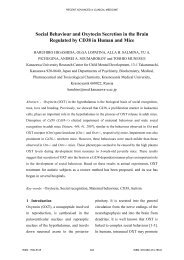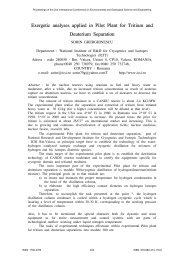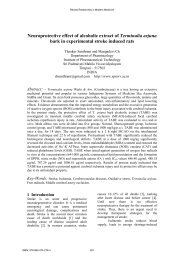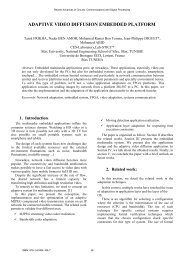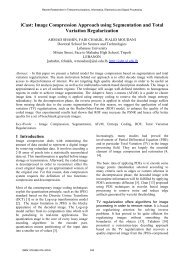The Matrix Padé Approximation in Systems of Differential ... - WSEAS
The Matrix Padé Approximation in Systems of Differential ... - WSEAS
The Matrix Padé Approximation in Systems of Differential ... - WSEAS
You also want an ePaper? Increase the reach of your titles
YUMPU automatically turns print PDFs into web optimized ePapers that Google loves.
<strong>WSEAS</strong> TRANSACTIONS on MATHEMATICSC. Pestano-Gab<strong>in</strong>o, C. Gonz_Lez-Concepcion, M.C. Gil-Far<strong>in</strong>asome rational elements and others which are not. Nextwe proceed to illustrate different cases.Our aim <strong>in</strong> this section is to detect rationalfundamental matrices (which are rectangular when theorder <strong>of</strong> the system is greater than 1). In other case, ifthis is not possible, then to detect particular rationalcolumns or particular rational solutions. If F(t) isrational then any solution <strong>of</strong> (1) is rational comply<strong>in</strong>gwith the aims. However, when F(t) is not rational andis <strong>in</strong> analytical form it would be <strong>in</strong>terest<strong>in</strong>g to know ifthere exist any <strong>in</strong>itial conditions, such that theassociated particular solution to be rational. It is noteasy to f<strong>in</strong>d the answer to this question <strong>in</strong> generalcases.We start with an example where the fundamentalmatrix is not rational but the system does have rationalsolutions.Example 1. Let Y''(t)=C(t) Y(t) be a differential2⎛ 1 t + 2 ⎞⎜ 2 3 ⎟(2 t) (2 t)system where C(t)= ⎜ − − ⎟ . Consider<strong>in</strong>g⎜24t − 8 6t ⎟⎜2 3 2 2(t + 2) (t + 2)⎟⎝⎠C(t)=∞∑i=0C tii, we obta<strong>in</strong> recursively the coefficients <strong>of</strong>the series for a fundamental matrix F(t)=follows:∞ ∞ ∞i i i+ +i+2=i ii= 0 i= 0 i=0∞∑i=0F tii∑(i 2)(i 1)F t ( ∑C t )( ∑ F t )(5)⎛<strong>The</strong>n, tak<strong>in</strong>g <strong>in</strong>to account (3), F 0 = 0 0 1 0 ⎞⎜ ⎟⎝0 0 0 1and⎠⎛F 1 = 1 0 0 0 ⎞⎜ ⎟ , and consider<strong>in</strong>g (5) we calculate the⎝0 1 0 0⎠ other coefficients us<strong>in</strong>g the follow<strong>in</strong>g expression:F i+2 =( ∑ i CjF i−j) /(i + 2)(i + 1) , i≥0 (6)j=0Fig. 1: Table 1 for F(t)0 1 2 3 4 50 0 0 0 0 0 01 2 2 2 2 2 22 4 4 4 4 4 43 6 6 6 6 6 64 8 8 8 8 8 85 10 10 10 10 10 10Note that F(t) is not rational <strong>of</strong> orders (p,q) such that0≤p




